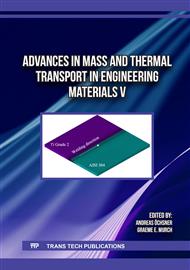[1]
P.P. E Kachroo, S.A. Wadoo, S.J. Al-Nasur, A. Shende, Pedestrian Dynamics Feedback Control of Crowd Evacuation (Springer, 2008)
DOI: 10.1007/978-3-540-75561-6_11
Google Scholar
[2]
R.M. Alexander, Principles of Animal Locomotion (University Press Princeton, 2003)
Google Scholar
[3]
A.F. Miguel, Physics of Life Reviews. 10 (2013) 168–190.
Google Scholar
[4]
C.R. Lee, C. T. Farley, Journal of Experimental Biology. 201 (1998) 2935–2944.
Google Scholar
[5]
C.E. Carr, J. McGee, PLoS One. 4 (2009) e6614
Google Scholar
[6]
P.E. Roos, J. B. Dingwel, Human Movement Science. 32 (2013) 984–996
Google Scholar
[7]
J. Cham, J.K. Karpick, M.R. Cutkosky, International Journal of Robotics Research. 23 (2004) 141–153.
Google Scholar
[8]
A.F. Miguel, A. Bejan, Physica A: Statistical Mechanics and its Applications. 388 (2009) 727–731.
Google Scholar
[9]
L.F. Henderson, D. M. Jenkins, Transportation Research. 8 (1974) 71–74.
Google Scholar
[10]
D. Helbing, P. Molnar, Physical Review E. 51 (1995) 4282–4286.
Google Scholar
[11]
A. Seyfried, B. Steffen, W. Klingsch, M. Boltes, Journal of Statistical Mechanics. 10 (2005) P10002.
DOI: 10.1088/1742-5468/2005/10/p10002
Google Scholar
[12]
A.F. Miguel, Physics of Life Reviews. 10 (2013) 206–209.
Google Scholar
[13]
D. Helbing, L. Buzna, A. Johansson, T. Werner, Transportation Science. 39 (2005) 1–24.
Google Scholar
[14]
A. Kirchner, K. Nishinari, A. Schadschneider, Physical Review E. 67 (2003) 056122.
Google Scholar
[15]
A.F. Miguel, Constructal patterns formation in nature, pedestrian motion and epidemics propagation, in: Constructal Theory of Social Dynamics, p.85–114 (Springer, 2007).
DOI: 10.1007/978-0-387-47681-0_5
Google Scholar
[16]
D.L. Katz, Medical Clinics of North America. 88 (2004) 1295–1320.
Google Scholar
[17]
M. Ohrstrom, J. Hedenbro, M Ekelund, European Journal of Surgery. 167 (2001) 845–850.
Google Scholar
[18]
E.L. Melanson, M.L. Bell, J.R, Knoll, L.B. Coelho, W. Donahoo, J.C. Peters, J.O. Hill, Medicine and Science in Sports and Exercise. 35 (2003) S183.
DOI: 10.1097/00005768-200305001-01016
Google Scholar
[19]
R.C. Browning, R. Kram, Obesity. 13 (2005) 891–899.
Google Scholar
[20]
M. Schimpl, C. Moore, C. Lederer, A. Neuhaus, J. Sambrook, J. Danesh, W. Ouwehand, M. Daumer, PLoS One. 6 (2011) e23299.
DOI: 10.1371/journal.pone.0023299
Google Scholar
[21]
C. M. Wall-Scheffler, Journal of Anthropology. 1 (2012) 1–9.
Google Scholar
[22]
R. W. Bohannon, Age Ageing. 26 (1997)15–19.
Google Scholar
[23]
A. Ble, S. Volpato, G. Zuliana, J.M. Guralnik, S. Bandinelli, F. Lauretani, B. Bartali, C. Maraldi, R. Fellin, L. Ferrucci, Journal of the American Geriatrics Society. 53 (2005) 410–415.
DOI: 10.1111/j.1532-5415.2005.53157.x
Google Scholar
[24]
A. Bejan, J. H. Marden, Journal of Experimental Biology. 209 (2006) 238–248.
Google Scholar
[25]
J.E. Bertram, A. Ruina, Journal of Theoretical Biology. 209 (2001) 445–453.
Google Scholar
[26]
C.T. Farley, T. A. McMahon, Journal of Applied Physiology. 73 (1992) 2709–2712.
Google Scholar
[27]
R. Kram, A. Domingo, D. P. Ferris, Journal of Experimental Biology. 200 (1997) 821–826.
Google Scholar
[28]
A. Seyfried, B. Steffen, W. Klingsch, T. Lippert, M. Boltes, Steps toward the fundamental diagram – empirical results and modelling, in: Traffic and Granular Flow´05, p.357–362 (Springer, 2007)
DOI: 10.1007/978-3-540-47641-2_26
Google Scholar
[29]
A.F. Miguel, Physics Letters A. 373 (2009) 1734–1738.
Google Scholar
[30]
A. Lloyd, M. Somerville, Journal of Workplace Learning. 18 (2006) 186–198.
Google Scholar
[31]
A.F. Miguel, International Journal of Design & Nature and Ecodynamics. 5 (2010) 230–241
Google Scholar
[32]
A. Jelic, C. Appert-Rolland, S. Lemercier, J. Pettré, Physical Review E. 86 (2012) 04611.
Google Scholar
[33]
A.F. Miguel, Physics of Life Review. 18 (2016) 37–39.
Google Scholar
[34]
A.F. Miguel, Journal of Theoretical Biology. 242 (2006) 954–961.
Google Scholar
[35]
A. Bejan, Shape and Structure from Engineering to Nature (Cambridge University Press, 2000).
Google Scholar
[36]
A.F. Miguel, Defect and Diffusion Forum. 407 (2021) 59–67.
Google Scholar


